Adventures of a Transplanted Gardener |
||||||||||
Florida natives for your landscape
|
||||||||||
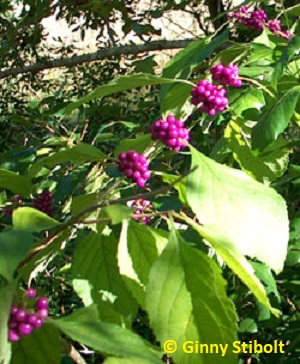 |
Beautyberry with its unbelievably magenta berries is an easy-care, native shrub. |
In my article on instant landscaping, I described a project where a landscaping company used only non-native plants. I suggested that gardeners would do well to choose native plants. Northern Florida and many other regions are losing diversity in the habitat because of loss of wild areas and because the same 20 or 30 species are over-planted in people's yards. This article provides suggestions, background, native plant lists, some starting points when planning your landscape, and other resources.
Why diversity in your landscape?
The simple answer is that we need many different plants to provide habitat for butterflies, birds, and other wildlife. More to the point, diversity is important for the health of the region's overall ecology. (I've listed links to detailed diversity articles below.) Far too many of our wild areas have been destroyed to make room for that most damaging crop springing up with increasing frequency: McMansions and their vast lawns. (More on lawns in this article.)
This is a huge issue, so what difference can gardeners make? Little by little, one-by-one, we have the power to effect dramatic results. We can enhance the diversity in our own neighborhoods by:
-
selecting a wide variety of native plants for our landscaping needs, and ask for native species when we deal with nurseries.
-
choosing plants suitable for the various microclimates on our properties so we use fewer resources, especially water, to maintain them.
-
creating wild or near wild spaces on our properties and keep your cats and dogs out of this space. (Pets are subsidized predators that significantly alter the balance in the ecosystem.) Encourage your neighbors to do the same.
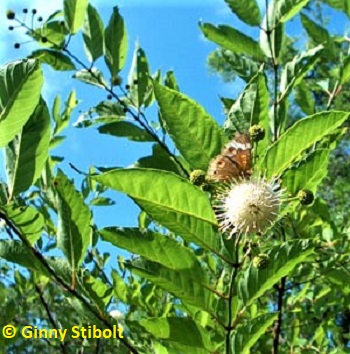 |
|
Growing at the edge of a pond, this Button Bush, with its odd,
globular flowers, attracts |
Why are native plants important?
The strict definition of a native plant is one that grew in northeast Florida before Europeans arrived. Considering plants native to the whole southeast region, ignoring our political boundaries, seems more practical. For instance, the two Magnolias (Magnolia grandiflora) planted by the previous owner on our property are compact cultivars from North Carolina and would not be considered native here. The Purple Cone Flower (Echinacea purpurea) is a prairie flower native to only one county in Florida's Panhandle, but that would not stop me from planting it here in North Florida, if I had the right spot for it and also knowing that it would probably be only an annual here.
Native plants provide food and cover for native animals. They provide more variety in our gardens by offering myriad alternatives to the oh-so-common cultivars and aliens. The biggest advantage to gardeners, though, is that natives simply grow better here, because they are adapted to our soil and climate.
There are some disadvantages of using natives:
-
They may be more difficult to find and more expensive initially (but not usually in the long run).
-
Because various insects and other animals eat the natives, they tend to look moth-eaten at times. Actually, they are moth-eaten and butterfly-eaten葉hose caterpillars have voracious appetites, but most plants have adapted to this situation, and will grow new leaves.
-
Natives may tend to be less compact and, due to their genetic diversity, they may be more unpredictable in their growth patterns.
Planning for planting
Before you start, observe (for a year or more) the various sections of your property. (During this observation period, if you have a bare landscape to deal with, plant annuals and work with containers to combat the urge to produce an instant landscape that you may regret later.)
You will want to identify areas:
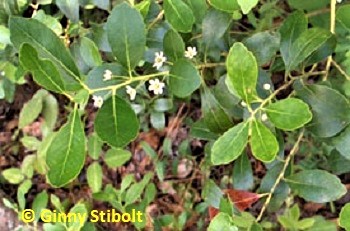 |
| Inkberry is a shrubby holly that does well in damp and partially shaded areas. Wildlife love its black berries. |
-
where water stands for a day or two after a good rain.
-
that tend to dry out in the heat of summer.
-
where the grass is not growing well.
-
that you and your family use for outdoor activities.
-
that make up your views from the inside of your house.
-
where you'd like to create more privacy.
Create a paper (or computer) layout of your land and write down your observations during the year. Those notes to yourself will be important as you formulate an overall plan. Choose plants that do well in the various microclimates and remove those that are misplaced. A microclimate problem we observed last summer was that the shrubs planted in the back bed suffered because of the afternoon sun on that westerly wall. We relocated the shrubs, and this year we planted heat-loving tomatoes and peppers there. Without that year of observation, we would not have thought to plant vegetables right next to the house. The back bed is an example of a microclimate, as the six-foot-wide garden is between a cement sidewalk and the slab foundation which both retain heat. Also, the afternoon sunlight reflects from the white siding. It's a hot microclimate.
Also, during this year of observation, roam around your neighborhood and nearby areas to see how well different plants grow in your area. Decide which landscaping ideas you like the best and watch those properties throughout the year to see how they look in each of the seasons. Observe also, how different plants look together. Some of my observations around our neighborhood changed my original ideas for new plantings on our property. After seeing how ratty the Dogwoods (Cornus florida) look around here, I'm not going to plant any even though it was one of my favorites in Maryland. This is its southernmost range and something here is causing the dogwoods too much stress容ven the blooms were mediocre and unlike Maryland where they bloom before the leaves emerge, here it blooms when the leaves have emerged.
In a landscape, you'll need to plan for three or four levels: full-sized trees, small trees and taller shrubs, medium height to low shrubs, and low-lying ground covers. Creating this understory layer of shade-tolerant shrubs and small trees beneath your trees provides cover for wildlife, interest in your landscape, and ultimately, places that don't need weeding. You'll also want to plan for different textures in your plantings. This means that you'll look for different sized and shaped plants and those with various types of leaves. Do your research so you know which plants grow well together, and how plants will look in each season. Combine plants that bloom at different times in the year and plan for some plants with showy fruits.
Plantings of all types look best in non-linear, odd-numbered groupings.
If you are starting with a bare lot, choose an area where you wish to plant some full-sized trees. Make sure this area is far enough from the house that the trees, when they are full grown, will not brush the siding or roof. Plant three or five trees in this area, and plan for enough space between them for optimal growth and development. Then plan for smaller trees and shrubs around the trees and finally, the ground covers. For instance, if the area is in a low-lying, non-lawn area where water sits for a few days after a rain or next to a pond, your full-sized tress could include these: Bald Cypress (Taxodium distichum) 130', Water Oak (Quercus nigra) 80', Southern Magnolia (Magnolia grandiflora) 100", Sweet Bay Magnolia (Magnolia virginiana) 100', Red Maple (Acer rubrum) 90', or Water Tupelo (Nyssa aquatica) 115'. The smaller trees and large shrubs could include some of these: Carolina Willow (Salix caroliniana) 35', Button Bush (Cephalanthus occidentalis) 10', Ink Berry (Ilex glabra) 10', Groundsel Tree (Baccaris halimifolia) 13', Southern Bayberry (Morella cerifera) 30', or Beauty Berry (Callicarpa americana) 6'. One obvious ground cover for a wet area is are ferns. For a dry area, you'd have different set of possibilities.
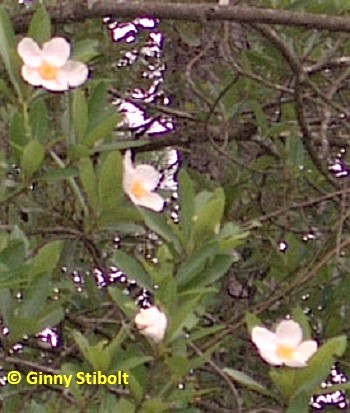 |
|
Loblolly bay, an evergreen, tall columnar tree rivals the Magnolias for year-round beauty. |
If you have existing, mature trees and plantings already in place, think of ways to form planting areas around the trees. If you have a lone pine tree in a dry area and grass struggling under it, stop raking up the pine needles, and create an acid-loving understory layer around it: Dahoon holly (Ilex cassine) 30', southern redcedar (Juniperus virginica) 30', winged sumac (Rhus copalina) 25', and saw palmetto (Serenoa repens), 6'. For the ground layer. you could use butterfly weed (Asclepias tuberosa) 2' and Black-eyed Susan (Rudebeckia hirta) 2'.
Select the plants and arrange them while keeping in mind the ultimate purpose of that area. If an area is to be used to create some privacy, you may wish to add height with a ridge葉hat ridge, especially if you use sandy soil, will become a drier microclimate where water drains away. Use lots of compost for each plant, but you'll still need drought-tolerant, evergreen shrubs and small trees to provide your screen. If an area will be the vista from your living room, you'll want to take more care to provide flowers, fruit, and varying textures throughout the seasons.
To help with your landscaping, befriend a good gardener in your neighborhood or contact your county agriculture office to help with identifications and other information. As you know, gardening is a process and patience is rewarded.
While I've discussed the small, garden-by-garden agenda here, I urge gardeners to get involved in regional initiatives to increase your community's use of native plants, and preservation of open space. Also join your local native plant society for finding like-minded people who are doing great things--for Florida see www.FNPS.org.
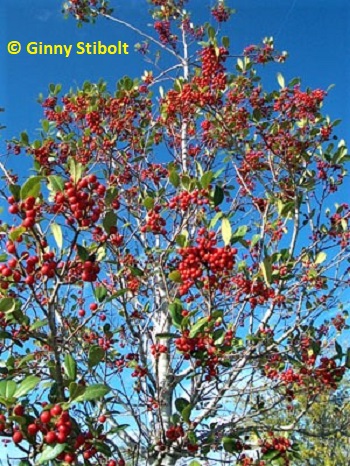 |
|
I found this dahoon holly growing in a pebble-filled parking lot island. Not even weeds grew there. |
A few suggestions for native shrubs and trees with comments:
(For many more choices, see the resources listed below.)
キ Coontie (Zamia
integrifolia) 3' is non-flowering plant and our only native
cycad. This small shrub has fern-like leaves and tolerates a variety
of conditions.
キ Beauty Berry (Callicarpa
americana)* 6' is a deciduous, medium-sized bush with unbelievably
magenta berries for damp areas in partial shade.
キ Saw Palmetto (Serenoa repens), 6' is an evergreen,
shrubby palm. It's very durable in all kinds of terrain and if
you have these, they are hard to get rid of, but are amazingly difficult
to transplant. I've had only one of ten survive.
キ Buttonbush (Cephalanthus occidentalis)* 10' is
a large, deciduous shrub with one-inch, white globular flowers for damp
areas. (The photo also shows Common Buckeye (Junonia coenia)
butterfly.)
キ Ink Berry (Ilex glabra)* 6' is an evergreen shrub預
holly with black berries. It does best at the edge of wooded areas.
キ Southern Bayberry (Morella cerifera) 30' is a fragrant,
evergreen, tall shrub. The gray berries attached along the stems
in the fall attract many birds. It grows well in a variety of
conditions and takes well to trimming.
キ Loblolly Bay
(Gordonia lasianthus)* 80' is a stunning tree that grows
wild at the edges of forested areas around our neighborhood. This
narrow, columnar tree rivals Magnolias for shear beauty.
キ Tupelo (Nyssa
silvatica) 100' is a deciduous tree, with irregularly twisting branches,
glossy leaves, and blue berries, grows in wet or dry conditions.
Its most noticeable characteristic is its brilliant scarlet fall color,
even here in Florida.
キ Bald Cypress (Taxodium distichum) 130' is
one of the few deciduous conifers, hence the name bald. This tree
will grow right in standing water or in dryer areas, but don't plant
it anywhere near where you'll be mowing葉hose woody knees will wreck
your lawnmower.
キ Dahoon Holly (Ilex cassine)* 30' is an easy-to-care-for
evergreen tree that will grow almost anywhere. Like other hollies,
there are male and female trees葉hey are dioecious. Make sure
you have one male to ensure those beautiful orange-red berries on the
females.
* Photo included.
Resources:
- Florida Backyard has plant lists including those to attract birds
and wildlife: www.nsis.org/
- Florida Native Plant Society has more than 30 chapters throughout
Florida and their website has good information and plant profiles for
native native to your region: www.fnps.org/
- The Florida Association of Native Nurseries list plants and
members: www.plantrealflorida.org/
- University of Florida Extension Service's website includes
many articles and extensive lists with detailed information on the characteristics
and environmental needs for each plant:
http://edis.ifas.ufl.edu/TOPIC_Native_Plants.
- The Florida Invasive Species Council maintains a list of exotic pest
plants for your reference: https://floridainvasivespecies.org/.
Ginny Stibolt is a life-long gardener, a botanist, a naturalist, and a garden writer. You may contact her or read more of her articles posted on her website: www.greengardeningmatters.com.
Copyright Ginny Stibolt

